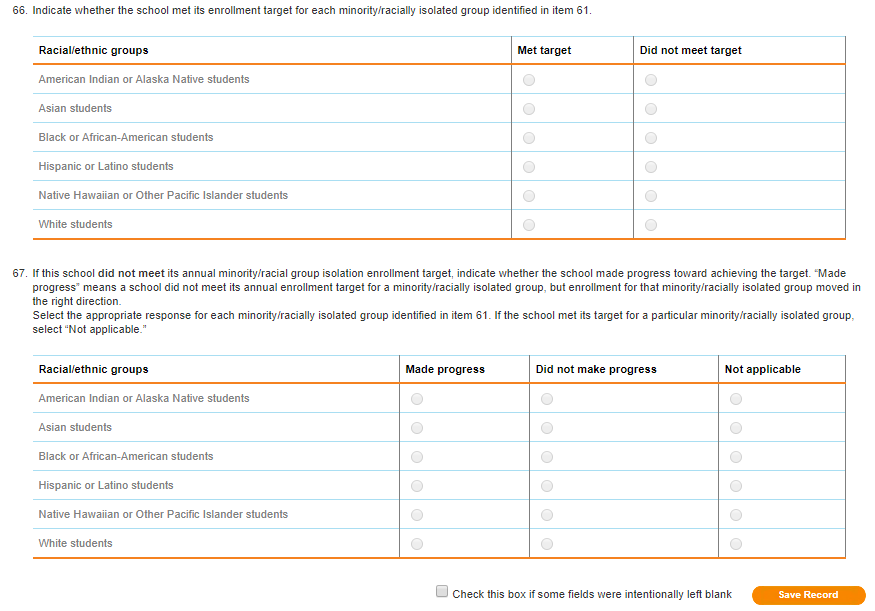MSAP GPRA Table Forms
Magnet Schools Assistance Program- Government Performance and Results Act (GPRA) Table Form
MSAP Instrument 1a GPRA Guide
MSAP GPRA Table Forms
OMB: 1855-0025
Magnet Schools Assistance Program:
Guidance for Reporting GPRA Modernization Act of 2010 Data
March 2018
Table of Contents
Magnet Schools Assistance Program Performance Measures 1
MSAP Project-Level Performance Measures 2
Part I: School Demographic Data 3
Part II: GPRA Performance Measure 1 Data 5
Reporting Data by Race/Ethnicity 6
Part III: GPRA Performance Measures 2 and 3 Data 9
Part IV: GPRA Performance Measure 4 Data 11
Part V: GPRA Performance Measure 6 Data 12
High School Graduation Rate Data 12
Part VI: Minority Group Isolation Data 14
GPRA Performance Measure Calculations 17
Appendix 1: OMB Racial and Ethnic Category Definitions 19
Appendix 2: OMB Racial and Ethnic Data Guiding Principles 20
Magnet Schools Assistance Program Performance Measures
Performance measures specify ways to assess performance and provide evidence to demonstrate progress toward achieving program-level and project-level objectives and purposes. There are two types of Magnet Schools Assistance Program (MSAP) performance measures:
Government Performance and Results Act (GPRA) goals—program-level measures established for reporting to Congress under the GPRA Modernization Act of 2010; and
Project-level performance measures—specific project-level measures that grantees establish in their approved grant applications to meet the project objectives.
The MSAP performance measures are part of the MSAP grant reporting requirements and must be assessed and reported as described in this guide. Project-level performance measures are developed at the grant level and approved by the U.S. Department of Education (ED). Grantees are required to use form ED 524B, Section A to (1) report MSAP project performance targets; (2) document actual performance; and (3) provide an explanation of progress for each of the MSAP project-level performance measures. The GPRA Table should be used to report on GPRA Performance Measures 1, 2, 3, 4, and part of 6 for the fiscal year (FY) 2016 cohort, on GPRA Performance Measures 1, 2, 3, and part of 5 for the FY 2017 cohort.
GPRA Performance Measures
As part of a government-wide effort to improve the performance and accountability of all federal programs, the U.S. Congress passed GPRA in 1993, establishing a process for using performance indicators to (1) set program performance goals; (2) measure and report program results; and (3) focus on quality of service and customer satisfaction. On January 4, 2011, Congress passed the GPRA Modernization Act of 2010. The Act improves on the original GPRA of 1993 and modernizes the federal government’s performance management framework. The GPRA Modernization Act of 2010 builds on the performance management approach to improve the effectiveness and efficiency of government by requiring that agency leaders set clear, ambitious goals for a number of outcome-focused and management priorities; measure, analyze, and communicate performance information to identify successful practices; and conduct in-depth performance reviews to identify progress on agency priorities.
GPRA Performance Measures are used by MSAP program staff and MSAP grantees to quantify and report progress toward meeting program-level objectives in annual performance reports as required in the GPRA Modernization Act of 2010. Annual performance reporting helps ED to (1) identify successes and potential challenges among grantees; (2) design MSAP technical assistance services; (3) provide performance reports to Congress; and (4) improve MSAP overall.
These are the MSAP GPRA Performance Measures for the FY 2016 cohort:
GPRA Performance Measure 1: The percentage of magnet schools receiving assistance whose student enrollment reduces, eliminates, or prevents minority group isolation.
GPRA Performance Measure 2: The percentage of students from major racial and ethnic groups in magnet schools receiving assistance who score proficient or above on State assessments in reading/language arts.
G
Program Level versus Project Level
Program-level measures address the performance of the program as a whole. All grantees in the 2016 and 2017 MSAP cohorts will report data from their projects. These data will be combined, or aggregated, to gauge the overall status of grantees and their progress toward meeting the program goals. MSAP program-level measures are the GPRA Performance Measures.
Project-level measures address the performance of an individual grantee. Each grantee sets objectives designed to meet the needs of its community and, because these are site-specific objectives, project-level data cannot be combined with data from other grantees. Instead, these data help the grantee and MSAP staff gauge the grantee’s progress and identify areas where technical assistance may be needed.
PRA Performance Measure 3: The percentage of students from major racial and ethnic groups in magnet schools receiving assistance who score proficient or above on State assessments in mathematics.GPRA Performance Measure 4: The cost per student in a magnet school receiving assistance.
GPRA Performance Measure 5: The percentage of magnet schools that received assistance that are still operating magnet school programs three years after federal funding ends.
GPRA Performance Measure 6: The percentage of magnet schools that received assistance that meet the State’s annual measurable objectives, and, for high schools, graduation rate targets at least three years after federal funding ends.
These are the MSAP GPRA Performance Measures for the FY 2017 cohort.
GPRA Performance Measure 1: The number and percentage of magnet schools receiving assistance whose student enrollment reduces, eliminates, or prevents minority group isolation.
GPRA Performance Measure 2: The percentage increase of students from major racial and ethnic groups in magnet schools receiving assistance who score proficient or above on State assessments in reading/language arts as compared to previous year's data.
GPRA Performance Measure 3: The percentage increase of students from major racial and ethnic groups in magnet schools receiving assistance who score proficient or above on State assessments in mathematics as compared to previous year's data.
GPRA Performance Measure 4: The percentage of magnet schools that received assistance that are still operating magnet school programs three years after Federal funding ends.
GPRA Performance Measure 5: The percentage of magnet schools that received assistance that meet the State's annual measurable objectives and, for high schools, graduation rate targets at least three years after Federal funding ends.
Grantees report data for these measures in the GPRA Table.
MSAP Project-Level Performance Measures
MSAP grantees must also report on project-level performance measures. These are the specific measures grantees established in their approved applications to address the MSAP Statutory Purposes. Grantees report data pertaining to project-level performance measures in the Project Status Chart of form ED 524B. For instructions on reporting these data, see the Dear Colleague Letter and the Instructions for Grant Performance Report (ED 524B Instructions).
Purpose of This Guide
This guide, referred to as the GPRA Guide, will assist MSAP grantees in accurately reporting GPRA Performance Measure data in the MSAP Annual Performance System (MAPS), which is accessed through the private workspace of the MSAP Center website (http://msapcenter.com). This guide provides essential information and special reporting considerations for completing the GPRA Table. The final section of this guide explains how ED will calculate each measure.
MSAP GPRA Table
Grantees are required to complete a separate GPRA Table for each school participating in their grant projects and submit the table(s) with the annual performance report (APR). When the APR is due in May, all of the data for Parts II, III, IV, V, and VI of the GPRA Table may not be available. Please include actual data for as many items as possible and leave blank the items for which data are not yet available. You will resubmit GPRA Tables with final data in your Ad Hoc report later in the year.
The reporting table consists of six parts: (1) Part I- School demographic data; (2) Part II- GPRA Performance Measure 1 data; (3) Part III- GPRA Performance Measures 2 and 3 data; (4) Part IV- GPRA Performance Measure 4 data; (5) Part V-GPRA Performance Measure 6 data; and (6) Part VI-Minority Group Isolation data. Refer to the appropriate sections of this guide for instructions on completing each part of the Table.
Note: Some data will be prepopulated in MAPS. You will need to verify these data (e.g., official school names). Some items cannot be edited by you because they should remain the same throughout the grant period; for example, school names should not change. These items are inactive, and you can identify them by the gray text. If for some reason you do need to change any of these items, you should contact your ED program officer to provide the new information and explain why you need to make the change. If approved, the program officer will contact the MSAP Center with the new information. The MSAP Center will make the change and contact you via e-mail to confirm that the change has been made.
Part I: School Demographic Data
T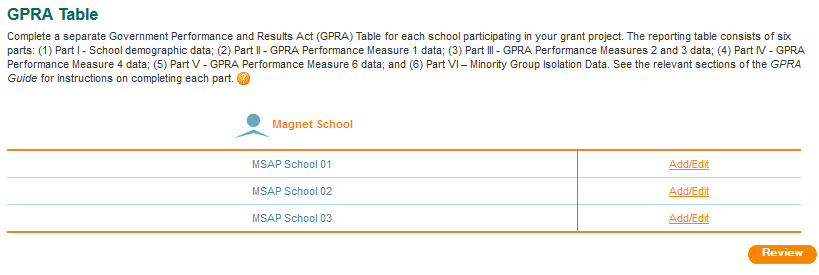 he
opening page of the GPRA Table lists the schools covered by your MSAP
grant; verify the official names. Click Add/Edit to move to Part I,
where you will begin to enter school data.
he
opening page of the GPRA Table lists the schools covered by your MSAP
grant; verify the official names. Click Add/Edit to move to Part I,
where you will begin to enter school data.
For each MSAP-funded school, complete items 1-9 of the GPRA Table. Follow the instructions below to complete the items.
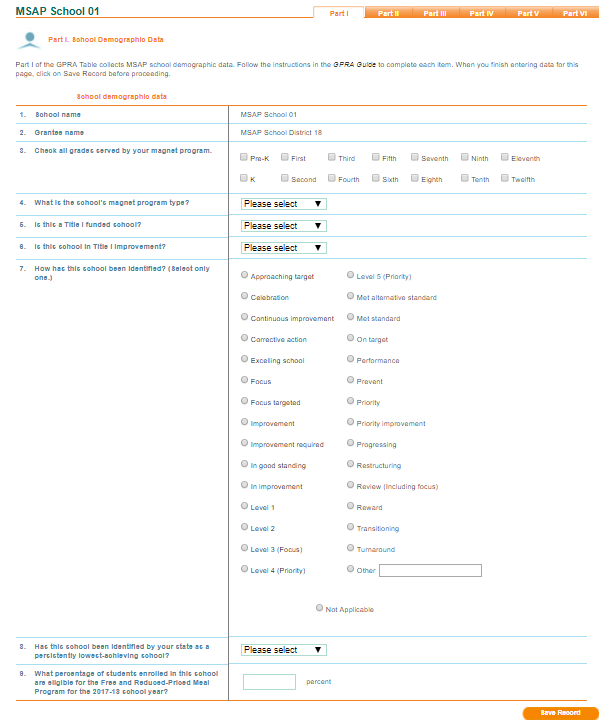
Item 1. Verify the official name of each MSAP-funded school.
Item 2. Verify the official name of the MSAP grantee. This is your local education agency, which might be a school district, consortium, or charter school.
Item 3. Check all grades served by the magnet program. If a school has grades K–8, but the magnet program serves only grades K-4, please indicate this by marking only grades K–4.
Item 4. Use the dropdown menu to indicate whether the school has a whole-school magnet program or a partial magnet program, also known as a “program within a school.”
Item 5. For school year 2017-18, indicate whether the school received Title I funding by selecting “Yes” or “No.”
Item 6. For school year 2017-18, indicate whether the Title I-funded school was in school improvement by selecting “Yes” or “No.”
Item 7. Identify the school’s accountability designation for the 2017-18 school year by selecting one of the options listed. These options have been expanded to include accountability designations recently developed by states. Previously, only Title I schools in improvement had to identify their school improvement stage. Some states now apply these accountability designations to all schools, regardless of Title I status. If this is the case in your state, please select the appropriate designation for each magnet school. If a school’s designation is not listed, select “Other” and then specify the name of the school’s designation that was established by your state as part of its accountability system. If the school has not received a designation, select “Not applicable.” For example, if one of your schools first opened in fall 2017, it may not have received a state designation yet.
Item 8. Indicate whether your state has identified the MSAP school as a “persistently lowest achieving school” by selecting “Yes” or “No.”
A persistently lowest achieving school, as determined by the state, is any Title I school in improvement, corrective action, or restructuring that (1) is among the lowest achieving five percent of Title I schools in improvement, corrective action, or restructuring, or the lowest achieving five Title I schools in improvement, corrective action, or restructuring in the state, whichever number of schools is greater; (2) is a high school that has had a graduation rate as defined in 34 CFR 200.19(b) that is less than 60 percent over a number of years; or (3) is a secondary school that is eligible for but does not receive Title I funds, and is among the lowest achieving five percent of secondary schools or the lowest achieving five secondary schools in the state that are eligible for but do not receive Title I funds, whichever number of schools is greater.
Item 9. Enter the percentage of students eligible for the Free and Reduced-Price Meal Program at this school for the 2016-17 school year or the most recent data available.
Part II: GPRA Performance Measure 1 Data
Part II of the GPRA Table collects information related to minority group isolation, in which applicant pool and student enrollment data are reported:
GPRA Measure 1: The percentage of magnet schools receiving assistance whose student enrollment reduces, eliminates, or prevents minority group isolation.
When reporting student applicant pool and enrollment data in items 10–28, use data reported as of October 1 for the appropriate cohort and grant year.
The dates for the FY 2016 cohort are as follows.
For grant Year 1, report the number of applications received and enrollments for fall 2017.
For grant Year 2, report the number of applications received and enrollments for fall 2018.
For grant Year 3, report the number of applications received and enrollments for fall 2019.
The dates for the FY 2017 cohort are as follows.
For grant Year 1, report the number of applications received and enrollments for fall 2018.
For grant Year 2, report the number of applications received and enrollments for fall 2019.
For grant Year 3, report the number of applications received and enrollments for fall 2020.
For grant Year 3, report the number of applications received and enrollments for fall 2021.
For grant Year 3, report the number of applications received and enrollments for fall 2022.
Reporting Data by Race/Ethnicity
Part II of the GPRA Table requires grantees to report student applicant pool and enrollment data by race and ethnicity using the following categories: American Indian or Alaska Native, Asian, Black or African-American, Hispanic or Latino, Native Hawaiian or Other Pacific Islander, White, and Two or more races.
In the Final Guidance on Maintaining, Collecting, and Reporting Racial and Ethnic Data to the U.S. Department of Education (Guidance) (72 FR 59266, Oct. 19, 2007), ED established new requirements for collecting and reporting disaggregated racial and ethnic data under the programs it administers. ED also announced that districts must begin reporting data using the new collection procedures and reporting categories no later than the 2010-11 school year.
Applicant Pool Data
Enter the total number of applications received for admission in fall 2018. This is the number of applications received from students who were actively recruited with MSAP funds and who have applied to enter in fall 2018. Report only raw numbers, not percentages; for example, if 20 of the 50 total applicants were Hispanic or Latino, report “20” for item 13, not “40%.” Continuing students often are not required to re-apply to the school; therefore, continuing students should be included in the enrollment data (items 27a-27g) but not in the applicant pool data.
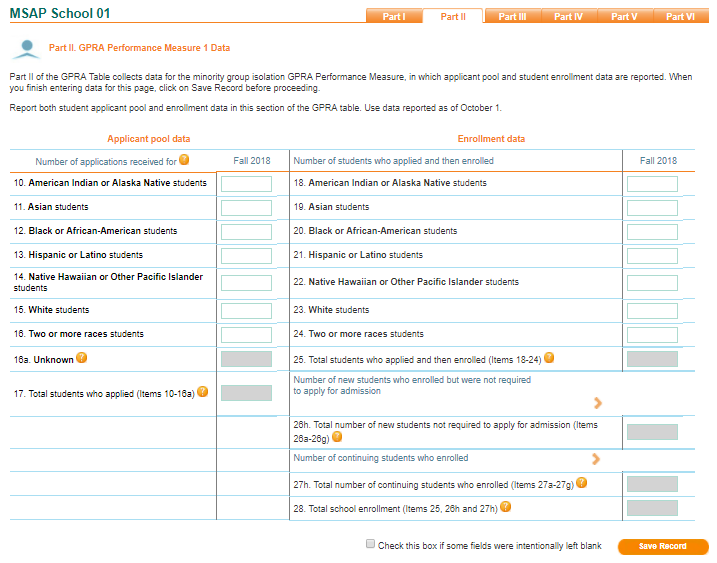
Items 10-16. Enter the number of student applications received for each racial and ethnic category included in the table.
Item 16a. This item may be used to report applicants who have not noted race/ethnicity on their application forms. If you have such applicants, please contact MSAP Center directly and the staff will open the cell for item 16a and notify you by e-mail when this has been done. This category does not appear in the enrollment section because all students should be identified by race and ethnicity when enrollment occurs.
Item 17. MAPS will automatically sum the total number of student applications received from the values reported in rows 10-16a. Please verify the sum for accuracy.
Note: During ad hoc reporting, the system will prevent you from moving on if fields are left blank in this section. However, if you have intentionally left some fields blank, check the box next to the Save Record button so you will be able to save and move on to the next section.
Enrollment Data
Items 18-24. Enter the total number of students who applied for fall 2018 admission and then enrolled by the racial and ethnic categories included in the table.
Item 25. MAPS will automatically sum the total number of student enrollments from the values reported in rows 18-24. Please verify the sum for accuracy.
Note: Use items 26a-26g and 27a-27g to report the students who enrolled but were not required to apply or who continued from the previous school year.
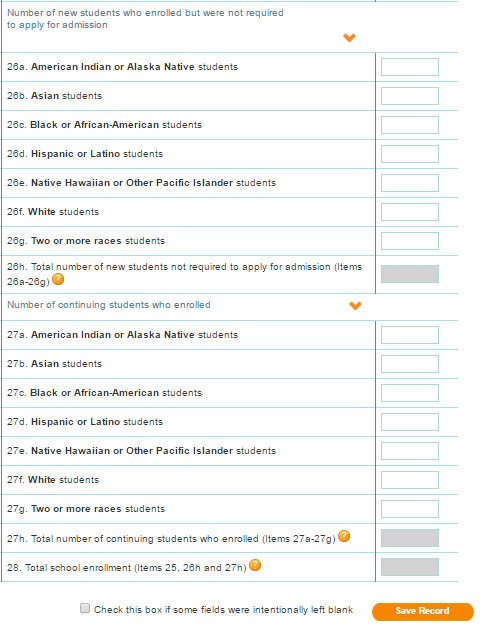
Item 26a- 26g. Enter the number of new students who enrolled but were not required to apply to the MSAP school by race and ethnicity (e.g., siblings of previously selected students, students who were admitted because of neighborhood status).
Item 27a -27g. Enter the number of continuing students by race and ethnicity. These are students who were already enrolled in the MSAP school and were not required to re-apply for admission. This includes MSAP students who enrolled in previous years.
Item 28. MAPS will automatically sum the total number of new and continuing students enrolled in the MSAP school from the values reported in items 25-27g. Please verify the sum for accuracy. The total number of students enrolled should represent the number of student enrolled as of the dates above the columns.
Note 1: When entering data in this section of the GPRA Table, please note the reporting period dates above the data columns in MAPS.
Note 2: When the APR is due in May, all final data for this section of the GPRA Table may not be available. Include actual data for as many items as possible and leave blank the items that are not yet available. You will complete this section again, using final data, for the Ad Hoc report due on October 31.
Note 3: During ad hoc reporting, the system will prevent you from moving on if fields are left blank in this section. However, if you have intentionally left some fields blank, check the box next to the Save Record button so you will be able to save and move on to the next section.
Part III: GPRA Performance Measures 2 and 3 Data
Part III of the GPRA Table collects data for the two student achievement measures:
GPRA Performance Measure 2: The percentage of students from major racial and ethnic groups in magnet schools receiving assistance who score proficient or above on State assessments in reading/language arts.
GPRA Performance Measure 3: The percentage of students from major racial and ethnic groups in magnet schools receiving assistance who score proficient or above on State assessments in mathematics.
In this section of the GPRA Table, see the following instructions for entering the numbers of students who took the state reading/language arts and mathematics assessments and the numbers of students who scored proficient or above on the assessments.
For the FY 2016 cohort, the dates are as follows:
For grant Year 1, report data for the 2016-17 school year.
For grant Year 2, report data for the 2017–18 school year.
For grant Year 3, report data for the 2018-19 school year.
For the FY 2017 cohort, the dates are as follows:
For grant Year 1, report data for the 2017-18 school year.
For grant Year 2, report data for the 2018–19 school year.
For grant Year 3, report data for the 2019-20 school year.
For grant Year 3, report data for the 2020-21 school year.
For grant Year 3, report data for the 2021-22 school year.
Student Achievement Data
The first three columns of this section capture state assessment participation data—that is, the number of students who participated in state assessments in reading/language arts and mathematics. The last three columns of this section capture student achievement data—that is, the number of students who participated in state assessments for reading/language arts and mathematics and who scored proficient or above on the reading/language arts and mathematics assessments.
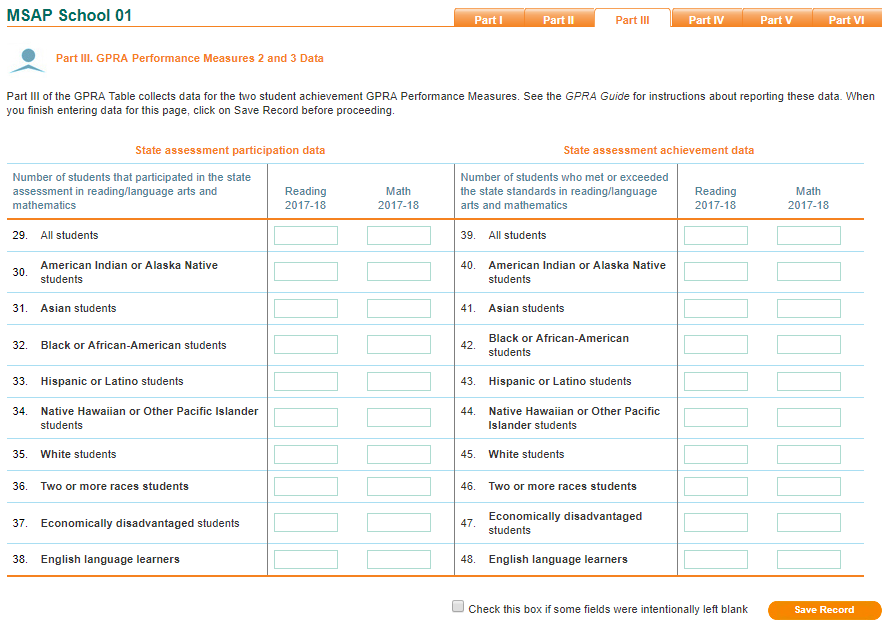
Item 29. Enter the total number of students who participated in the state assessment in reading/language arts and mathematics. This total should represent the school population who participated in the assessments, not the total school enrollment.
Items 30-36. Enter the total number of students, by the racial and ethnic categories shown here, who participated in the state assessments in reading/language arts and mathematics. Again, these numbers should represent the students, by racial and ethnic group, in the school who participated in testing, not the total enrollment numbers.
Item 37. Enter the total number of economically disadvantaged students who participated in the state assessments in reading/language arts and mathematics. Again, this number should represent all economically disadvantaged students who participated in testing, not the total enrollment.
Item 38. Enter the total number of English language learners who participated in the state assessments in reading/language arts and mathematics. Again, this number should represent all English language learners who participated in testing, not the total enrollment.
Item 39. Enter the total number of students who scored proficient or above on the state assessments in reading/language arts and mathematics. This total should represent the student population who took the assessments and were proficient or above the state standards in reading/language arts and mathematics.
Items 40-46. Enter the total number of students who scored proficient or above on the state assessments in reading/language arts and mathematics by the racial and ethnic categories shown here. This total should represent all students, by racial and ethnic categories, who took the assessments and were proficient or above the state standards in reading/language arts and mathematics.
Item 47. Enter the total number of economically disadvantaged students who scored proficient or above on state assessments in reading/language arts and mathematics. This total should represent all economically disadvantaged students who took the assessments and were proficient or above the state standards in reading/language arts and mathematics.
Item 48. Enter the total number of English language learners who scored proficient or above on the state assessments in reading/language arts and mathematics. This total should represent all English language learners who took the assessments and were proficient or above the state standards in reading/ language arts and mathematics.
Note 1: When entering data in this section of the GPRA Table, please see the grant reporting year dates above the data columns in MAPS.
Note 2: When reporting data for each category, make sure the number of students who met or exceeded state standards is not greater than the number of students who participated in assessments.
Note 3: Do not report data for students who participated in state assessments or who met or exceeded state standards for student groups identified by your state as unreportable. Unreportable subgroups typically have low numbers of students who participated in state assessments and/or who met or exceeded state standards. Leave the fields blank for identified unreportable subgroups.
Note 4: When the APR is due in May, final data for this section of the GPRA Table may not be available. Include actual data for as many items as possible, and leave the items blank when data are not yet available. You will complete this section again, using final data, in the Ad Hoc report due October 31.
Note 5: Use the same method to calculate student achievement data each year of the grant cycle so the data are consistent.
Note 6: During ad hoc reporting, the system will prevent you from moving on if fields are left blank in this section. However, if you have intentionally left some fields blank, check the box next to the Save Record button so you will be able to save and move on to the next section.
Part IV: GPRA Performance Measure 4 Data
Part IV of the GPRA Table collects data on the total number of students served by the magnet program. These data are important for calculating an efficiency measure. FY 2017 grantees do not need to report these data.
GPRA Performance Measure 4: The cost per student in a magnet school receiving assistance.

Item 49. Enter the total dollar amount of MSAP funds spent on the magnet program at this school during the year. This is not a cumulative dollar amount for the 3-year grant project and does not pertain to how much money was allocated for the year; it is important to report how much money is actually spent at this school in 2017-18.
Note: If you have more than one MSAP school, and you have MSAP expenditures that impact all schools (e.g., the cost of a Grants Manager), divide the expenditures by the number of schools. Then include the per-school cost in each school’s total expenditures.
Item 50. Enter the total number of students served by the magnet program at this school in the 2017-18 school year.
Note: When entering data in this section of the GPRA Table, please note the grant reporting year date above the data column in MAPS.
Part V: GPRA Performance Measure 5/6 Data
Part V of the GPRA Table collects high school graduation rates. High school graduation rate data will be collected annually to establish trend data. However, the annual measurable objective data will be collected 3 years after the grant ends.
GPRA Performance Measure 5/6: The percentage of magnet schools that received assistance that meet the State’s annual measurable objectives and, for high schools, graduation rate targets at least three years after Federal funding ends.
High School Graduation Rate Data
In this section of the GPRA Table, see the following instructions for entering the number of students in the four-year adjusted cohort and the number of students who graduated.
For the FY 2016 cohort, the dates are as follows:
For grant Year 1, report data for the 2016-17 school year.
For grant Year 2, report data for the 2017–18 school year.
For grant Year 3, report data for the 2018-19 school year.
For the FY 2017 cohort, the dates are as follows:
For grant Year 1, report data for the 2017-18 school year.
For grant Year 2, report data for the 2018–19 school year.
For grant Year 3, report data for the 2019-20 school year.
For grant Year 3, report data for the 2020-21 school year.
For grant Year 3, report data for the 2021-22 school year.
The first column of this section captures four-year adjusted cohort data—this number is defined as the cohort members who enter the school as 9th grade freshmen plus students who transfer in, minus students who transfer out, emigrate to another country, or die during the same four-year period. The second column captures the number of cohort members who earned a regular high school diploma within the same four-year period. The last column of this section captures the graduation rate—that is, the percentage of students who graduated. This percentage will automatically calculate in MAPS.
Note: Only MSAP-funded high schools are required to complete items 51-60. This section will have gray text if the school is not a high school.
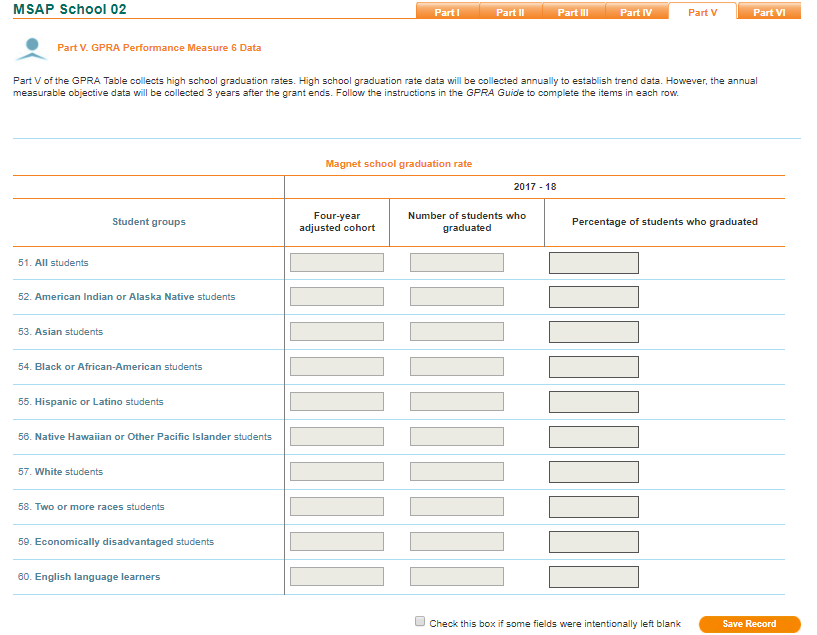
Item 51. Enter the total number of students in the cohort. This number should represent the cohort members who entered the school as 9th grade freshmen plus students who transferred in, minus students who transferred out, emigrated to another country, or died during the same four-year period. Enter the total number of students who graduated. This number should represent all students in the four-year adjusted cohort who received a regular diploma.
Items 52-58. Enter the total number of students in the cohort by the racial and ethnic categories shown here. Again, these numbers should represent students in the four-year adjusted cohort by racial and ethnic categories. Enter the total number of students, by racial and ethnic categories, who graduated. This number should represent all students, by racial and ethnic group, in the four-year adjusted cohort who received a regular diploma.
Item 59. Enter the total number of economically disadvantaged students in the cohort. This number should represent all students in the four-year adjusted cohort who are economically disadvantaged. Enter the total number of economically disadvantaged students who graduated. This number should represent all economically disadvantaged students in the four-year adjusted cohort who received a regular diploma.
Item 60. Enter the total number of English language learners in the cohort. Again, this number should represent all English language learners in the four-year adjusted cohort. Enter the total number of English language learners who graduated. This number should represent all English language learners in the four-year adjusted cohort who received a regular diploma.
Note: During ad hoc reporting, the system will prevent you from moving on if fields are left blank in this section. However, if you have intentionally left some fields blank, check the box next to the Save Record button so you will be able to save and move on to the next section.
Part VI: Minority Group Isolation Data
Part VI of the GPRA Table also collects data for calculating GPRA performance measure 1 outcomes for each minority/racially isolated group in a magnet school.
GPRA Performance Measure 1: The percentage of magnet schools receiving assistance whose student enrollment reduces, eliminates, or prevents minority group isolation.
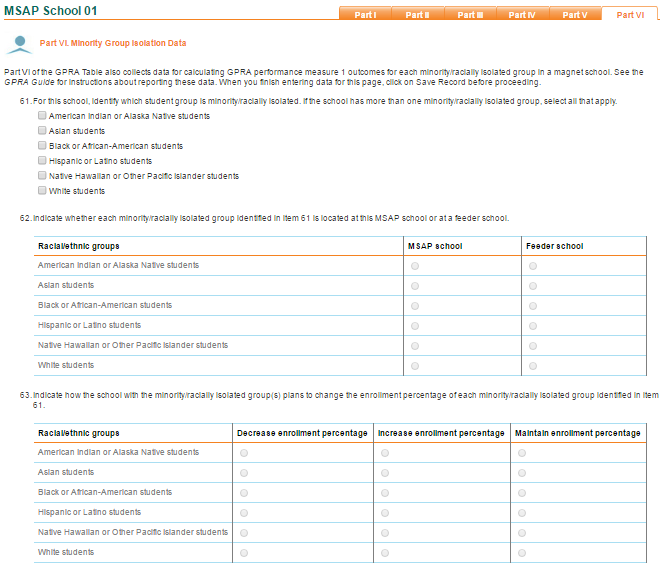
Item 61. Select the minority/racially isolated group. Select each minority/racially isolated group that was identified for this school and approved by ED.
Item 62. For each minority/racially isolated group selected in item 61, indicate whether the group is located in this MSAP school or in a feeder school by checking the appropriate box. Choose a school category for each minority/racially isolated group selected in item 61.
Item 63. Indicate how the school with the minority/racially isolated group plans to change the enrollment percentage by checking either “decrease enrollment percentage,” “increase enrollment percentage,” or “maintain enrollment percentage.” Choose a category for each minority/racially isolated group selected in item 61.
Item 64. Identify the targeted racial/ethnic group that the school with the minority/racially isolated group wants to enroll. The targeted racial/ethnic group is the group the school would like to enroll more of in order to change the enrollment of the minority/racially isolated group. Select each racial/ethnic group that represents the students the school wants to enroll to change minority/racial group isolation.
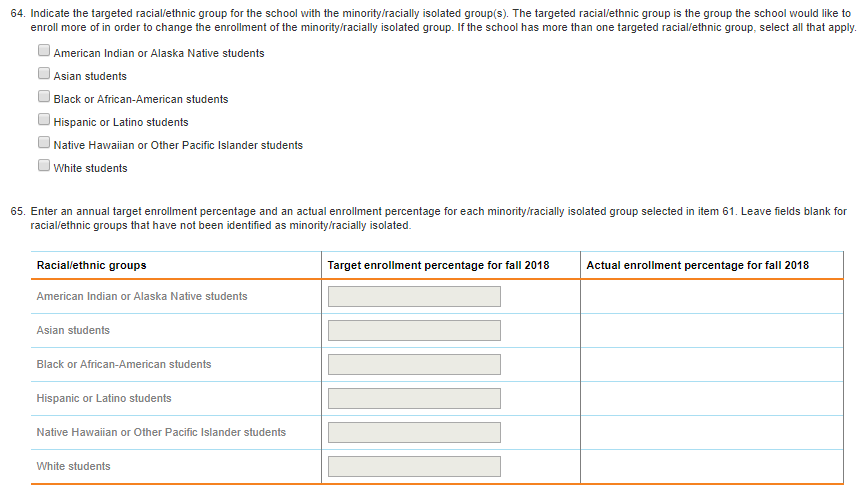
Item 65. Enter the annual target enrollment percentage for each minority/racially isolated group selected for item 61 in the first column of item 65. MAPS will automatically populate the actual enrollment field, the second column of item 65, with the enrollment percentage for the minority/racially isolated group selected. The enrollment percentage will be calculated based on the enrollment data reported for the corresponding racial/ethnic group in Part II of the GPRA Table.
Item 66. Indicate whether the school met its enrollment target for each minority/racially isolated group selected in item 61 by checking either “met target” or “did not meet target.” Select “met target” if the school achieved or exceeded its enrollment target for that minority/racially isolated group and select “did not meet target” if the school did not achieve or exceed its annual target for that group.
Item 67. Indicate whether the school made progress toward achieving its target if it did not meet its annual enrollment target for each minority/racially isolated group. “Made progress” means a school did not meet its annual enrollment target for a minority/racially isolated group, but enrollment for that minority/racially isolated group moved in the right direction. Select the appropriate response for each minority/racially isolated group identified in question 61. If the school met its target for a particular minority/racially isolated group, select “Not applicable.”
GPRA Performance Measure Calculations
GPRA Performance Measures will be calculated using data reported in the GPRA Table as well as additional data captured after the grant ends. The formulas for analyzing each GPRA Performance Measure are described below:
GPRA Performance Measure 1: The percentage of magnet schools receiving assistance whose student enrollment reduces, eliminates, or prevents minority group isolation.
This is a yearly aggregate measure. The total number of schools receiving assistance whose student enrollment reduces, eliminates, or prevents minority group isolation will be divided by the total number of schools.
GPRA Performance Measure 2: The percentage of students from major racial and ethnic groups in magnet schools receiving assistance who score proficient or above on State assessments in reading/language arts.
This is a yearly aggregate measure. The total number of students who score proficient or above on state assessments in reading/language arts will be divided by the total number of students participating in state reading/language arts assessments.
GPRA Performance Measure 3: The percentage of students from major racial and ethnic groups, in magnet schools receiving assistance who score proficient or above on State assessments in mathematics.
This is a yearly aggregate measure. The total number of students who scored proficient or above on state assessments in mathematics will be divided by the total number of students who participated in state mathematics assessments.
GPRA Performance Measure 4: The cost per student in a magnet school receiving assistance.
This measure is calculated by dividing item 49 (total annual MSAP funds expended at a school) by item 50 (total number of students served by the school’s magnet program).
GPRA Performance Measure 4/5: The percentage of magnet schools that received assistance that are still operating magnet school programs three years after Federal funding ends.
This is a long-term measure. A contractor will be hired by the program to contact grantees 3 years after funding has ended to determine the percentage of magnet schools still in operation.
GPRA Performance Measure 5/6: The percentage of magnet schools that received assistance that meet the State’s annual measurable objectives and, for high schools, graduation rate targets at least three years after Federal funding ends.
This is also a long-term measure. However, to establish trend data, high school graduation rate data will be collected annually. The high school graduation rate is calculated by dividing the number of students who graduated by the number of students who form the four-year adjusted cohort.
Appendix 1: OMB Racial and Ethnic Category Definitions
In 1997, the Office of Management and Budget (OMB) adopted new standards for classifying race and ethnicity and provided guidelines in 2000. On October 19, 2007, the U.S. Department of Education (ED) issued guidance on how education institutions should collect and maintain racial and ethnic data, as well as how these data will be aggregated and reported to ED. Implementation of this new guidance was required by fall 2010, in time to report data for the 2010-11 school year. The definitions for the racial and ethnic categories in the GPRA Table are below. These appear as provided in Revisions to the Standards for the Classification of Federal Data on Race and Ethnicity, available on the OMB website at http://www.whitehouse.gov/omb/fedreg/1997standards.html.
American Indian or Alaska Native. A person having origins in any of the original peoples of North and South America (including Central America), and who maintains a tribal affiliation or community attachment.
Asian. A person having origins in any of the original peoples of the Far East, Southeast Asia, or the Indian subcontinent including, for example, Cambodia, China, India, Japan, Korea, Malaysia, Pakistan, the Philippine Islands, Thailand, and Vietnam.
Black or African American. A person having origins in any of the black racial groups of Africa. Terms such as "Haitian" or "Negro" can be used in addition to "Black or African American."
Hispanic or Latino. A person of Cuban, Mexican, Puerto Rican, South or Central American, or other Spanish culture or origin, regardless of race. The term "Spanish origin" can be used in addition to "Hispanic or Latino."
Native Hawaiian or Other Pacific Islander. A person having origins in any of the original peoples of Hawaii, Guam, Samoa, or other Pacific Islands. The term "Native Hawaiian" does not include individuals who are native to the state of Hawaii by virtue of being born there. In addition to Native Hawaiians, Guamanians, and Samoans, this category would include the following Pacific Islander groups reported in the 1990 census: Carolinian, Fijian, Kosraean, Melanesian, Micronesian, Northern Mariana Islander, Palauan, Papua New Guinean, Ponapean (Pohnpelan), Polynesian, Solomon Islander, Tahitian, Tarawa Islander, Tokelauan, Tongan, Trukese (Chuukese), and Yapese. The Interagency Committee recommended that data for Central and South American Indians be included in the American Indian or Alaska Native category.
White. A person having origins in any of the original peoples of Europe, the Middle East, or North Africa.
Appendix 2: OMB Racial and Ethnic Data Guiding Principles
As part of the 2007 revision to OMB Directive 15, Standards for the Classification of Federal Data on Race and Ethnicity (http://www.whitehouse.gov/omb/fedreg_1997standards), the Interagency Committee developed the following principles to govern the review process:
The racial and ethnic categories set forth in the standards should not be interpreted as being primarily biological or genetic in reference. Race and ethnicity may be thought of in terms of social and cultural characteristics as well as ancestry.
Respect for individual dignity should guide the processes and methods for collecting data on race and ethnicity; ideally, respondent self-identification should be facilitated to the greatest extent possible, recognizing that, in some data collection systems, observer identification is more practical.
To the extent practicable, the concepts and terminology should reflect clear and generally understood definitions that can achieve broad public acceptance. To assure they are reliable, meaningful, and understood by respondents and observers, the racial and ethnic categories set forth in the standard should be developed using appropriate scientific methodologies, including the social sciences.
The racial and ethnic categories should be comprehensive in coverage and produce compatible, non-duplicative, exchangeable data across federal agencies.
Foremost consideration should be given to data aggregations by race and ethnicity that are useful for statistical analysis and program administration and assessment, bearing in mind that the standards are not intended to be used to establish eligibility for participation in any federal program.
The standards should be developed to meet, at a minimum, federal legislative and programmatic requirements. Consideration should also be given to needs at the state and local government levels, including American Indian Tribal and Alaska Native village governments, as well as to general societal needs for these data.
The categories should set forth a minimum standard; additional categories should be permitted provided they can be aggregated to the standard categories. The number of standard categories should be kept to a manageable size, determined by statistical concerns and data needs.
A revised set of categories should be operationally feasible in terms of burden placed upon respondents; public and private costs to implement the revisions should be a factor in the decision.
Any changes in the categories should be based on sound methodological research and should include evaluations of the impact of any changes not only on the usefulness of the resulting data but also on the comparability of any new categories with the existing ones.
Any revision to the categories should provide for a crosswalk at the time of adoption between the old and the new categories so that historical data series can be statistically adjusted and comparisons can be made.
Because of the many and varied needs and strong interdependence of federal agencies for racial and ethnic data, any changes to the existing categories should be the product of an interagency collaborative effort.
Time will be allowed to phase in any new categories. Agencies will not be required to update historical records.
The new directive should be applicable throughout the U.S. federal statistical system. The standard or standards must be usable for the decennial census, current surveys, and administrative records, including those using observer identification.
Appendix 3: Glossary
Applicant pool. Students who must apply for admission to a magnet program and are actively recruited using MSAP funds.
Four-year adjusted cohort. From the beginning of 9th grade, students who are entering that grade for the first time form a cohort that is subsequently “adjusted” by adding any students who transfer into the cohort later during the 9th grade and the next 3 years and subtracting any students who transfer out, emigrate to another country, or die during the same period (http://www2.ed.gov/policy/elsec/guid/hsgrguidance.pdf).
Limited English
proficient. Limited English proficient has the meaning given the
term in
section 9101(25) of ESEA, [34 CFR 300.27] [9101(25) of
ESEA].
Magnet school. Magnet school means a public elementary school, public secondary school, public elementary education center, or public secondary education center that offers a special curriculum capable of attracting substantial numbers of students of different racial backgrounds [50 FR 21191, May 22, 1985, as amended at 51 FR 20414, June 4, 1986; 54 FR 19508 and 19509, May 5, 1989; 57 FR 61509, Dec. 24, 1992; 60 FR 14865, Mar. 20, 1995; 69 FR 4996, Feb. 2, 2004].
Persistently lowest achieving schools. Persistently lowest achieving schools means, as determined by the state, any Title I school in improvement, corrective action, or restructuring that (1) is among the lowest achieving 5 percent of Title I schools in improvement, corrective action, or restructuring or the lowest achieving five Title I schools in improvement, corrective action, or restructuring in the state, whichever number of schools is greater; (2) is a high school that has had a graduation rate as defined in 34 CFR 200.19(b) that is less than 60 percent over a number of years; or (3) any secondary school that is eligible for, but does not receive, Title I funds that is among the lowest achieving 5 percent of secondary schools or the lowest achieving five secondary schools in the state that are eligible for, but do not receive, Title I funds, whichever number of schools is greater.
| File Type | application/msword |
| File Title | Magnet Schools Assistance Program (MSAP) |
| Author | tcflower |
| Last Modified By | SYSTEM |
| File Modified | 2018-04-19 |
| File Created | 2018-04-19 |
© 2026 OMB.report | Privacy Policy
